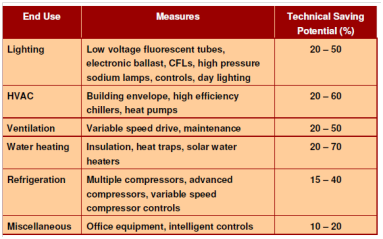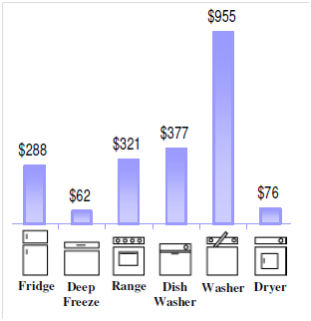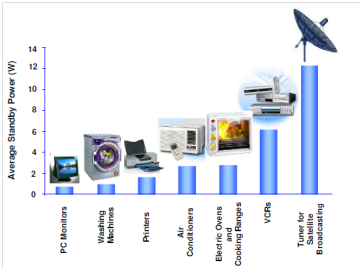Improving Energy Efficiency of Buildings and Appliances
Much of energy use occurring inside buildings consists of requirements for space heating/cooling, cooking, water heating, lighting and appliances. Commercial building energy consumption can be decreased through an average of 55% primarily by controlling lighting and air conditioning loads.
Specific technological measures which can be taken to conserve energy inside buildings involve:
a.) Improved levels of insulation in roofs and floors, walls, to decrease heat losses through these elements;
b.) Energy-efficient windows, (e.g., double glazing windows) designed to permit less heat to escape whilst still admitting huge amounts of sunlight;
c.) Draught-proofing and heat recovery systems to decrease heat loss by ventilation whilst retaining sufficient fresh air within the building;
d.) More efficient boilers that need a smaller fuel input to achieve a given level of space or water heating, together along with improved insulation of pipes to decrease heat losses;
e.) Energy-efficient lights which need much smaller amounts of power to provide a given level of illumination, e.g., CFLs along with the choice of the lamp type/number according to the requires of several areas within a building envelope. Table illustrates the energy saving potential within the commercial sector.
Table: Energy Saving Potential in the Commercial Sector

Below figure shows some ways of ensuring energy efficiency in buildings.

Figure: Six Steps to Energy Efficient Building
Improving the energy efficiency of domestic appliances is also a priority area. Energy-efficiency of appliances like as refrigerators, washing machines, cooking ranges, dishwashers, TV sets and hi-fi equipment in the domestic sector is improving day through day; more efficient computers, copiers and other business equipment are being used in the commercial and institutional sector. These consume less energy whilst delivering the similar level of service as their inefficient predecessors.

Figure: For Each Appliance Type, the Figure indicates how Much Money (in USD) can be saved During the Life of the Appliance, simply by choosing the Most Efficient Model rather than the Least Efficient
Various countries have now enacted legislation aimed at boosting the efficiency of products such as clothes washers, water heaters and air conditioners. Increasing global trade and industrial joint ventures in household appliances has meant in which all countries are seeing a rapid improvement in the quality and efficiency of refrigerators, freezers, washers, TVs etc. at extremely little extra cost. For example, high efficiency, multi-stage, multi-speed compressors are made through only a few large companies, and used in almost all new units. Various countries such as China are developing high efficiency refrigerators and freezers which use better controls, multi-stage compressors, and vacuum insulation.
Awareness campaigns for energy efficiency are also significant to create user awareness about the proper use of appliances. For instance, we suppose that household appliances in the standby mode consume extremely little energy. Figure presents useful information on power consumption through a variety of household appliances while these are not being used. You could compute the energy being consumed over a period of time. Your findings would be an eye-opener! Improved control systems are in use to ensure in which energy-consuming equipment is switched off while not required, and power output levels match the requirements of users.

Figure: Power Consumed by Various Devices and Appliances in the Standby Mode
Community energy planning also falls under the common category of demand side management. Municipal governments, developers, planners, businesses and residents should make sure which homes and communities are built in a way that conserves energy. This can be completed through encouraging clustered housing, implementing building codes for improving energy efficiency, making mandatory the use of double glazed windows particularly within buildings having energy consumption above 500 kW and etc.
Therefore, it goes without saying that energy conservation and efficiency measures are the best options for DSM. We now summaries the energy efficiency options for the customers for decreasing energy demand.
Energy Efficiency Options for Consumers
1 High efficiency motors and variable speed drives
2 Industrial process improvements and controls
3 Heat recovery
4 Passive solar modifications such as day lighting, design, siting and orientation of buildings, and space heat and cooling
5 High efficiency lighting technology and design
6 Building insulation and high efficiency windows
7 Energy management systems
8 High efficiency heat pumps
9 High efficiency home and office equipment and appliances
10 High efficiency water heaters (heat pumps, solar)
11 High efficiency cooling systems (chillers, air conditioning, cool storage, evaporative cooling, outside air economizers)
At this stage you might like to take a break and reflect on the ideas presented so far. Below you learn in these topics which present some ideas of how you can do your bit for improving energy efficiency and conserving energy.
Of course, you know the reasons why DSM is significant for utilities: the cost of reducing demand through one kW of electricity is substantially lower than the cost of adding one kW of generation. The environmental gains by preventing such generation are a bonus.
Utilities in the developed countries have instituted comprehensive DSM measures, such as free or subsidized distribution of energy efficient systems and appliances, and provision of up-front financing on reasonable terms for energy efficiency investments made through the consumers. The costs incurred are added to the rate base of the utility so in which the expenditure incurred is accorded the similar status as expenditure incurred in capacity addition.
Therefore, the experience in the developed countries describe that getting the energy prices right is a essential but not a enough condition for inducing consumers to use energy efficiently. Apart the industrial consumers, residential and commercial consumers are numerous, every with a relatively little amount of consumption. From their perspective, front-end costs of changing over to energy efficient demand side management (DSM) options (such as compact electronic ballasts, fluorescent lamps, energy efficient motors, improved switchgear, compressors and consumer durables, heating and cooling systems and etc.) are far too high compared to the relief they get in monthly energy bills.
One of the ways for energy efficiency services is by energy service companies (ESCOs).